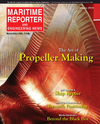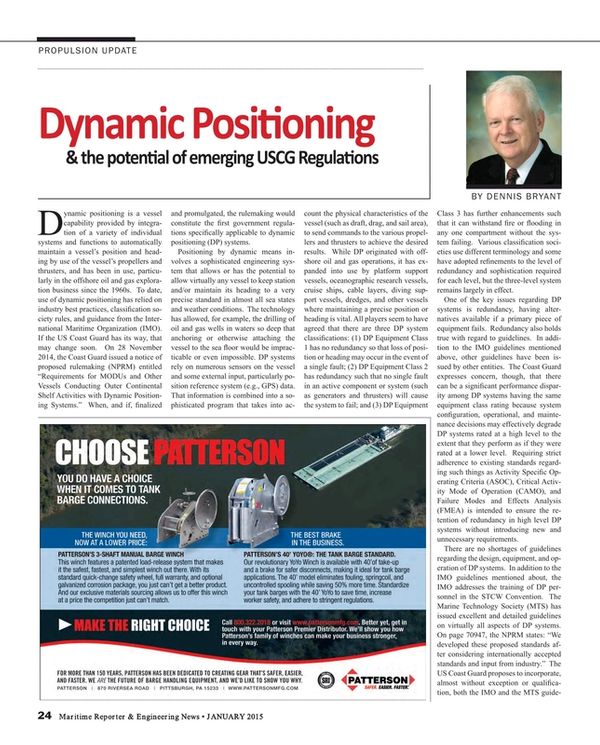
Dynamic Positioning & the Potential for USCG Regulations
Dynamic positioning is a vessel capability provided by integration of a variety of individual systems and functions to automatically maintain a vessel’s position and heading by use of the vessel’s propellers and thrusters, and has been in use, particularly in the offshore oil and gas exploration business since the 1960s. To date, use of dynamic positioning has relied on industry best practices, classification society rules, and guidance from the International Maritime Organization (IMO). If the US Coast Guard has its way, that may change soon. On 28 November 2014, the Coast Guard issued a notice of proposed rulemaking (NPRM) entitled “Requirements for MODUs and Other Vessels Conducting Outer Continental Shelf Activities with Dynamic Positioning Systems.” When, and if, finalized and promulgated, the rulemaking would constitute the first government regulations specifically applicable to dynamic positioning (DP) systems.
Positioning by dynamic means involves a sophisticated engineering system that allows or has the potential to allow virtually any vessel to keep station and/or maintain its heading to a very precise standard in almost all sea states and weather conditions. The technology has allowed, for example, the drilling of oil and gas wells in waters so deep that anchoring or otherwise attaching the vessel to the sea floor would be impracticable or even impossible. DP systems rely on numerous sensors on the vessel and some external input, particularly position reference system (e.g., GPS) data. That information is combined into a sophisticated program that takes into account the physical characteristics of the vessel (such as draft, drag, and sail area), to send commands to the various propellers and thrusters to achieve the desired results. While DP originated with offshore oil and gas operations, it has expanded into use by platform support vessels, oceanographic research vessels, cruise ships, cable layers, diving support vessels, dredges, and other vessels where maintaining a precise position or heading is vital. All players seem to have agreed that there are three DP system classifications: (1) DP Equipment Class 1 has no redundancy so that loss of position or heading may occur in the event of a single fault; (2) DP Equipment Class 2 has redundancy such that no single fault in an active component or system (such as generators and thrusters) will cause the system to fail; and (3) DP Equipment Class 3 has further enhancements such that it can withstand fire or flooding in any one compartment without the system failing. Various classification societies use different terminology and some have adopted refinements to the level of redundancy and sophistication required for each level, but the three-level system remains largely in effect.
One of the key issues regarding DP systems is redundancy, having alternatives available if a primary piece of equipment fails. Redundancy also holds true with regard to guidelines. In addition to the IMO guidelines mentioned above, other guidelines have been issued by other entities. The Coast Guard expresses concern, though, that there can be a significant performance disparity among DP systems having the same equipment class rating because system configuration, operational, and maintenance decisions may effectively degrade DP systems rated at a high level to the extent that they perform as if they were rated at a lower level. Requiring strict adherence to existing standards regarding such things as Activity Specific Operating Criteria (ASOC), Critical Activity Mode of Operation (CAMO), and Failure Modes and Effects Analysis (FMEA) is intended to ensure the retention of redundancy in high level DP systems without introducing new and unnecessary requirements.
There are no shortages of guidelines regarding the design, equipment, and operation of DP systems. In addition to the IMO guidelines mentioned about, the IMO addresses the training of DP personnel in the STCW Convention. The Marine Technology Society (MTS) has issued excellent and detailed guidelines on virtually all aspects of DP systems. On page 70947, the NPRM states: “We developed these proposed standards after considering internationally accepted standards and input from industry.” The US Coast Guard proposes to incorporate, almost without exception or qualification, both the IMO and the MTS guidelines, as well as several others found to be relevant. The NPRM, on page 70946, states, for example:
[W]e propose to incorporate IMO MSC/Circ.645 into regulations as mandatory provisions. We also propose to adopt in regulations DP guidance issued by the Marine Technology Society (MTS) as mandatory provisions to provide owners or operators of DP MODUs and other vessels essential information on how to meet some of the requirements of this notice of proposed rulemaking (NPRM).
In other words, a goal of the rulemaking is to mandate that all participants adopt proven best practices. In analyzing the costs of this proposal, the Coast Guard notes that costs should be minimal because, for the most part, the regulated entities already are or should be taking actions that incur these costs, thus the added expense in many instances is almost zero. The major difference between the current process of voluntary guidelines and the proposed US Coast Guard rulemaking is that, when and if implemented, the USCG regulations will mandate certain operational procedures, reporting, and recordkeeping. While not creating many new provisions in this regard, there is a major paradigm shift that deserves attention. Failure to comply with those operational procedures and reporting requirements, as subsumed by the Coast Guard rulemaking, could result in civil penalties. Intentional failure to comply with the recordkeeping and reporting requirements could result in criminal charges against both the individual and the vessel owner and operator.
By rough count, there are at least 15 different reports and records that are to be maintained with regard to covered vessels with DP systems. It is assumed that most are maintained properly now, but there may be exceptions. In the future, exceptions may have consequences, even when no casualty results therefrom. One of the sets of records to be maintained involves the resumes and vessel-specific work records of all key DP personnel. Let’s assume that one of those persons materially fudged his or her resume at some time in the past – perhaps by falsely claiming to have taken a particular training course. If the Coast Guard proposal is adopted, that old but fraudulent entry in a resume may have severe legal consequences.
For the most part, I heartedly endorse the Coast Guard approach to regulation of this important and expanding technology. By adopting industry standards, the Coast Guard is minimizing the burden on good operators while working to bring others up to the accepted mark. Any bad apples should be weeded out. The legal impacts of mandating previously voluntary records and reports are an unfortunate but natural secondary consequence. Your view may differ. Either way, your comments should be submitted to the Coast Guard by February 26.
The Author
Dennis L. Bryant is with Maritime Regulatory Consulting, and a regular contributor to Maritime Reporter & Engineering News as well as online at MaritimeProfessional.com.
t: 1 352 692 5493
e: [email protected]
(As published in the January 2015 edition of Maritime Reporter & Engineering News - http://magazines.marinelink.com/Magazines/MaritimeReporter)
Read Dynamic Positioning & the Potential for USCG Regulations in Pdf, Flash or Html5 edition of January 2015 Maritime Reporter
Other stories from January 2015 issue
Content
- Editorial: BWTS. Like it or Not, Here it Comes page: 6
- Marine Casualties & Fast Ferry Follies page: 8
- Bayonne Drydock Logs Successful '14 page: 10
- N-KOM Sees Increased Tanker Business page: 10
- Limitless Salvage page: 12
- What Keeps ‘Good Ship’ RINA Buoyant page: 20
- Dynamic Positioning & the Potential for USCG Regulations page: 24
- Chemical Tanker Turned OSV page: 26
- Shipbuilding, Repair and Conversion: Brazil's Quick Fix page: 30
- The Ballast Water Management Conundrum page: 34
- The Art of Propeller Making page: 44
- Lindner Sees Strong 2015 page: 48
- Beyond the Black Box page: 50
- BICERA Explosion Relief Valve page: 53
- Transas: The Bridge to Tomorrow page: 54
- Volvo Penta Debuts New Marine Engines page: 56
- VapCor Introduces Lindemann Marine Products page: 56
- New YANMAR EPA Tier III Engine page: 56
- New Gasket from Victaulic page: 56
- Clean Seal Molded Specialties Launched page: 56
- Dometic Debuts New Product Line page: 56
- First Container for LNG Hybrid Barge page: 56
- Wärtsilä to Power LNG-fueled RoPax Ferry page: 56
- Kidde Fire Systems: Multi-Language ARIES NETLink page: 56
- Next Generation Bridge Concept page: 57
- BCG Delivers Training Upgrades page: 58
- RescueME MOB1 page: 58
- New Stereo from ASA Electronics page: 58


